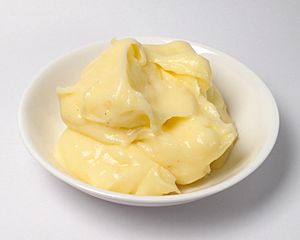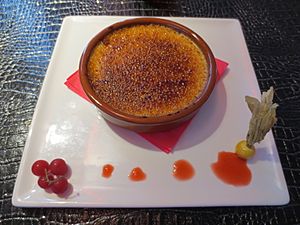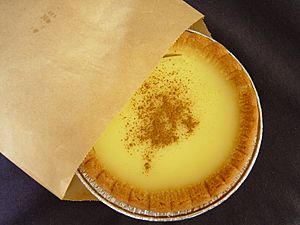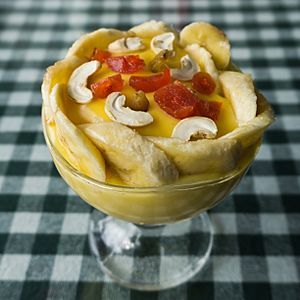Custard facts for kids
|
A bowl of crème anglaise custard, dusted with nutmeg
|
|
| Course | Dessert |
|---|---|
| Main ingredients | Milk or cream, egg yolks, sugar, vanilla |
Custard is a yummy food made by cooking a mix of milk or cream and egg yolks. It can be thin like a pouring sauce (called crème anglaise) or thick like a cream used to fill éclairs. How thick it is depends on how much egg or other thickener is used.
Most custards are sweet and are used as desserts or dessert sauces. They usually have sugar and vanilla in them. Sometimes, things like flour, corn starch, or gelatin are added to make them even thicker, like in pastry cream.
Making custard needs care! It's usually cooked in a special pot called a double boiler (or bain-marie). This means cooking it gently over hot water, not direct heat. You can also bake it in the oven, sometimes in a water bath to keep the heat even. Custard can even be steamed or cooked in a pressure cooker. It's important not to cook it too much, or it might curdle (get lumpy).
History of Custard
People have been mixing milk and eggs and cooking them for a long time! This kind of food has been around in Europe since at least Ancient Rome.
In the Middle Ages, custards baked inside pastry (like custard tarts) were very popular. This is actually where the English word 'custard' comes from. The French word 'croustade' originally meant the crust of a tart. This word came from the Italian word crostata, which finally came from the Latin word crustāre.
Today, the name 'custard' is sometimes used for similar dishes that are thickened with starch instead of just eggs, like blancmange.
Different Kinds of Custard
While "custard" can mean many thickened dishes, in fancy French cooking, a true "custard" (crème or crème moulée) is only thickened with eggs.
When starch is added, it's often called pastry cream or confectioners' custard. This type is made with milk or cream, egg yolks, sugar, and some flour or other starch. It usually has a flavor like vanilla, chocolate, or lemon. Crème pâtissière is a very important ingredient in many French desserts and filled tarts. It's also used in Italian pastries and sometimes in Boston cream pie.
Not all custards are sweet! A quiche is a savory (not sweet) custard tart. Some dishes like timbale or vegetable loafs are made with a custard base mixed with savory ingredients. Custard royale is a thick custard cut into fun shapes and used to decorate soup or stew. In Germany, it's called Eierstich and is used in German Wedding Soup.
Chawanmushi is a Japanese savory custard that is steamed and served in a small bowl. Chinese steamed egg is a similar, but larger, savory egg dish from China.
Custard can also be used as a top layer in baked dishes called gratins. For example, in the South African dish bobotie and many Balkan versions of moussaka.
How Custard is Used
Here are some popular desserts that use sweet custard:
- Banana custard
- Bavarian cream
- Boston cream pie
- Bougatsa
- Cream pie
- Crème brûlée
- Crème caramel
- Custard tart, also called egg custard
- Egg tart
- English trifle
- Flan
- Floating island
- Frozen custard
- Galaktoboureko
- Kremna rezina
- Muhallebi
- Natillas
- Pastel de nata
- Taiyaki
- Vanilla slice
- Vla
- Zabaglione
See also
 In Spanish: Crema (gastronomía) para niños
In Spanish: Crema (gastronomía) para niños









